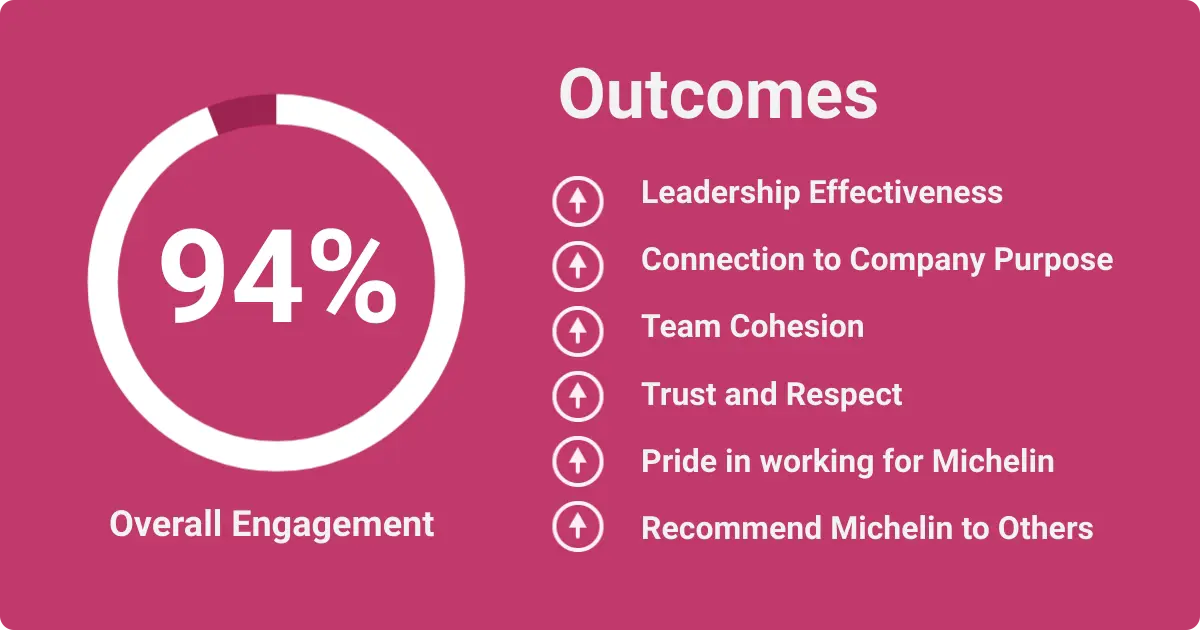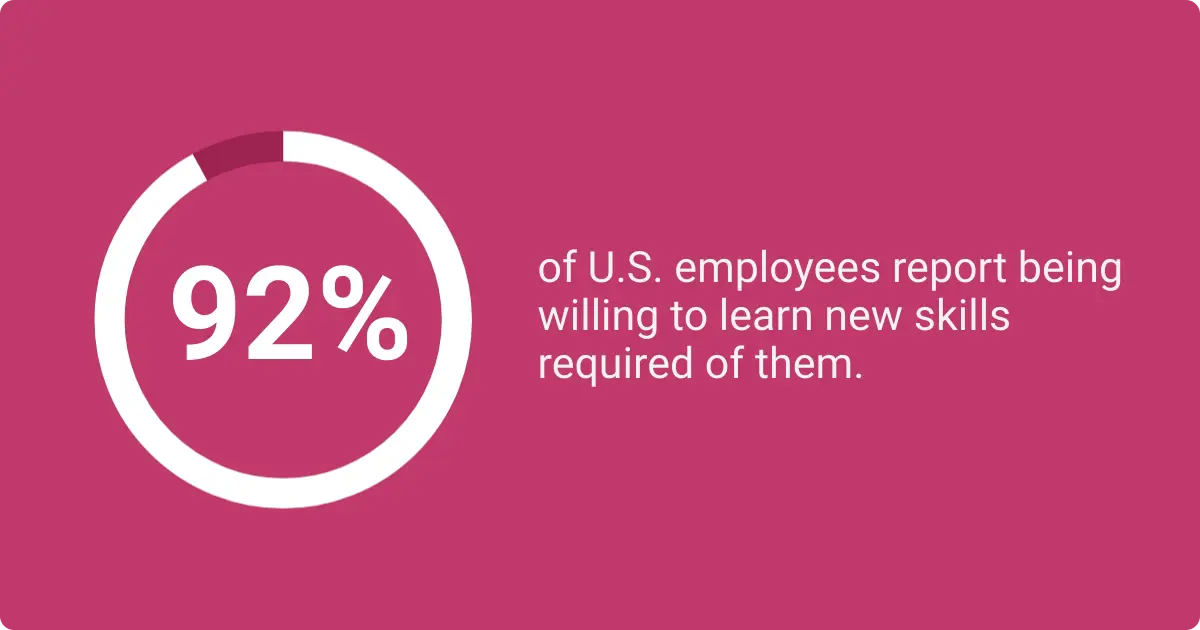How to Develop Leaders at Your Organization

When it comes to future-proofing your organization, leadership development is one of the most effective ways to ensure longevity.
However, building effective leadership development programs isn’t always straightforward. How can you create a sustainable program that develops leaders by establishing relevant and necessary skills in your multi-faceted employees?
Michelin, the international tire company (and of food guide fame), faced this question head-on when developing their now renowned leadership and talent development program. Leslie Schall, Director of Employee Experience, Engagement and Purpose, took the stage at Workhuman Live in Austin for a breakout session on how this came to be.
Read on to learn about the program’s structure – and its industry-leading success.
Michelin’s leadership development mission
Michelin is guided by a simple purpose: finding a better way forward.
The Michelin Group was founded by the Michelin family all the way back in 1889, and the “family feeling” is critical to the company’s culture.
A few years ago, Michelin leaders became concerned that the future leaders of the company might not connect with this cultural influence and wanted to explore ways to create a stronger leadership pipeline.
After a few successful but short-lived efforts, Schall was tasked with finding a better way forward for fostering emerging leaders and their leadership skills.
How Michelin designed their leadership development program
Staying true to Michelin’s roots, Schall simply started asking employees: what does finding a better way forward mean to you?
When she followed up with, “When you don’t have a better way forward, what’s the cause?” nearly 85% of respondents said it was their manager who held them back.
Armed with this data, Schall decided to partner with a consulting group to design a management training program.
As she got into the strategy and structure of leadership development programs, she identified a few must-haves:
- Keep it connected to the Michelin origin story while staying relevant.
- Use outside-the-box methods to drive home new skills.
- Give leaders a true toolkit, not just a few takeaways.
- Help employees identify driving purpose in themselves and in others.
- Must be relevant and applicable to Michelin’s wide range of employees, from manufacturing line operators to engineers and creatives.
As Schall got deeper into exploring purpose with potential future leaders, she identified a gap: purpose is a hard-to-define topic that many people find uncomfortable.
She and her team soon uncovered that a language framework made approaching these conversations a lot easier and gave potential leaders equal footing to discuss purpose. They used weather terminology to moderate these conversations, asking prompts like, “What kind of weather do I want to go into this conversation with? Should it be stormy and turbulent or bright and sunny?”
It also gave these developing leaders a way to respond when things got difficult: “It feels like it’s raining when in reality we’re just dealing with a few clouds.”
Soon, Schall and her team had created a two-hour session to drill down on purpose. They defined different categories of purpose to help each employee identify their own – and enable them to recognize it in others.
In these sessions, facilitators handed out thank-you cards with simple instructions to write them to anyone participants felt worthy. In the end, most of the present employees wanted to read theirs out loud to their 500 fellow attendees.
For more guidance on employee feedback, check out the white paper "9 Tips for Giving Feedback (Without the Stress)" today.
The results from these workshops were astounding:

Schall instantly knew they had to roll the workshop and overall leadership development program out – and fast.
Ensuring a lasting legacy in leadership development
Michelin launched their leadership development program as fast as they could. Despite it being an option, 85% of managers signed up.
After launch, their focus turned to sustainability. How can we ensure this leadership development system has a lasting impact?
One crucial step was moving away from paper thank-you cards onto a strategic employee recognition platform. Michelin partnered with Workhuman to make this happen.
The Michelin team identified a few key imperatives as they designed their recognition program, “WeCare.”
Make it personal
For employees and future leaders to buy into the importance of purpose, they had to have a personal investment in the topic. Making the program personal gives it a sense of relevancy and relatability to all participants, regardless of their department or role.
Create discussion frameworks
In addition to the weather language, Michelin employees use Bruce D Schneider’s Energy Leadership® principles to facilitate important conversations.
Link decisions to strategy
Just as everything needs to tie back to Michelin’s motto, leadership development needs to tie back to the company’s overall strategy. The company awards incentives and rewards accordingly.
They also designed their platform to match Michelin’s branding but with a more casual feeling, making the platform fun and enjoyable to use while feeling consistent with the broader Michelin brand.
Act like a coach more than a boss
Bosses make demands – coaches validate. A key way to validate leadership skills and identify future leaders? Recognition.
Michelin has found that employees receiving at least two rewards per year have significantly lower levels of attrition, signaling the impact that recognition has on both engagement and turnover. Recognition also helps managers identify potential future leaders who might have gone unnoticed otherwise, significantly improving their leadership pipeline.
While you are learning about the idea of managing people, it is essential to understand how recognition works. Read why recognition is the currency of human connection and enhance workplace experiences.
Everyone is a leader
Michelin makes it clear: everyone is a leader. This ethos is pervasive in their culture and how they view the process of succession planning. It instills in employees the belief that they can achieve whatever they want within the organization, making for an engaged, motivated workforce.
Make leadership development mandatory
All Michelin managers are required to do some form of leadership development every year. Michelin incentivizes this by increasing variable pay for those taking on development opportunities. The company has seen an uptick in manager quality every year since instating these guidelines.
Creating sustainable leadership development programs
Michelin’s WeCare story proves that employees want to upskill and feel valued when they are given the time and resources to hone their leadership skills.
This is consistent with existing research. A study by LinkedinOpens in a new tab showed that 94% of employees were willing to stay with a company that offers talent development programs.

So, how can you create a sustainable leadership development program that has a lasting impact on your organization and overall culture?
Constantly evaluate employees’ skills - By keeping a pulse on an employee’s skills profile, you can identify both when they are excelling and when they might be encroaching on a skills gap. You can also use this information to deliberately place a high-potential employee in a role that will force them to develop their weaknesses, making them into a stronger overall potential leader.Be transparent - Employees can’t know what they need to do to succeed if you don’t tell them. Be clear about how talent data is used and let employees have access to their own information.Mitigate bias - It’s all too easy to overlook high-potential candidates if you don’t take steps to mitigate your own bias. Bias is always at play, in both subtle and predictable ways. Instead of assuming you’re the exception to the rule, put safeguards in place when filling leadership positions. Workhuman’s AI Assistant uses your employee data to make smart suggestions about which employees could fill an open role, leading to sometimes surprising but always strategic options.Pitfalls to avoid when developing leaders
Michelin’s success proves the importance of treating all employees as potential leaders. With this approach, leadership development and succession planning go hand in hand.
As a piece by Harvard Business Review points out, treating the two separately makes it all too easy to overlook high-potential employees.
Combining leadership development with succession planning prompts constant oversight of employees’ skills alongside an education system to build them.
Another pitfall to avoid as you develop leaders is concealing the reasons and methods behind promotions and leadership roles. It’s no longer true that employees will be motivated by the simple concept of being promoted – they want to know what they’re working toward and that their aspirations are realistic.
About the author
Maeve Ginsberg
A wellness enthusiast and the mid-day walk’s #1 fan, Maeve champions work-life balance.
Having gone from a corporate job to self employment, Maeve has lived through countless working styles. This evolution forced confrontation of her own limiting beliefs, eventually breeding a completely individualized approach to work and productivity.
As a Senior Copywriter, Maeve often writes on workplace wellbeing and strives to advocate for all workers and leaders to find small yet significant ways to make their work lives healthier and more fulfilling.
Offline, Maeve enjoys testing new cuisines and hanging upside down off walls (also known as bouldering).